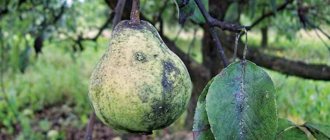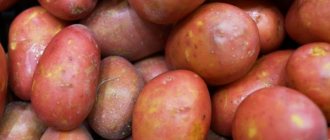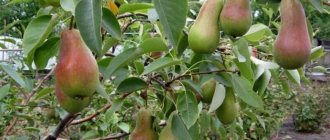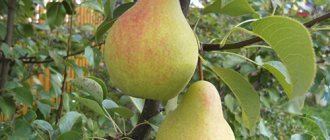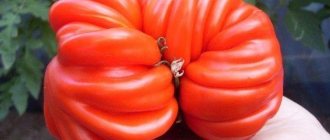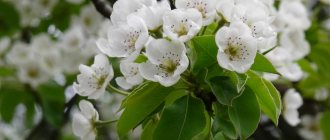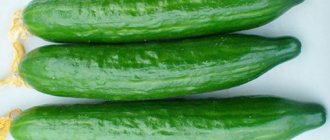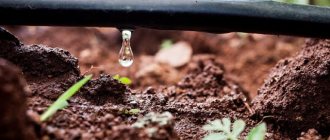Many varieties of fruit trees have “beauty” in their names. But it is rarely associated with the word “forest”, because, as a rule, fruit trees are the result of the painstaking work of breeders. Sometimes you get lucky, and then a pear appears from the forest with fruits worthy of the brush of Dutch artists, and the taste rivals those of selected varieties.
- 2 Description and characteristics of the variety
2.1 What will grow from the pear tree Forest beauty
- 4.1 Video: how to prune a pear correctly
Description of the variety
The autumn pear variety Forest Beauty comes from Belgium, where it was once discovered in the forest by accident. Since then it has received many other names: Alexandrina, Flemish Beauty, Marie-Louise. The latter is erroneous, since, according to the European classification, this is a completely different variety. According to the classification of L.P. Simerenko variety is also called Oil tree.
The forest beauty is a medium-sized tree (average height is 5 m), it grows quickly up to 10 years. The tree has a wide pyramid-shaped crown with medium-density foliage. The branches are slightly drooping, straight, dark red in color, and relatively thick. The buds are small, the leaves are finely serrated, with long petioles. Small, pink flowers are very resistant to temperature changes.
It must be remembered that ovaries form only on branches of the third or fourth year. Therefore, if you want truly high yields, you must definitely remove excess branches.
Ripe fruits acquire a yellow color and a bright blush.
The trees of the pear variety in question are very durable: there is information about specimens that lived up to 100–150 years. In terms of frost resistance, Forest Beauty is considered the leader among Western European varieties (it tolerates frosts down to -50 °C).
The fruits of the Forest Beauty are not very large, the average weight is 150–180 g, rare specimens can reach 280–300 g. Their shape resembles a blunt egg. The peel is quite dense, but thin and slightly rough. The fruits when ripe (the last ten days of August) are greenish-yellow in color; when fully ripe, they become golden-yellow, and on the illuminated side are covered with blush. Also, ripe fruits may have grayish dots and rust-colored spots. The pulp is pleasant to the taste, sour, yellowish-white, slightly oily and very juicy.
Video: What is good about the Forest Beauty?
What type of pear is it?
The Forest Beauty pear is an excellent high-yielding autumn pear variety with a rich history and many advantages.
With its help, more than 30 new varieties of pears, very common today, were obtained.
Among the autumn varieties, it is worth paying attention to Bere Bosk, Talgarskaya krasavitsa, Uralochka, Quiet Don and Otradnenskaya.
Advantages and disadvantages
Like any other pear variety, Forest Beauty has both advantages and disadvantages.
Pros:
- good yield;
- pleasant taste of fruits;
- immunity to low temperatures and heat, drought;
- long lifespan and long-term fruiting;
- unpretentiousness to soil conditions.
Disadvantages of the variety:
- fruits fall off easily in the wind;
- pears must be picked unripe to avoid shedding;
- the harvest does not last long;
- fruits and leaves are often infected with scab.
Reviews from gardeners about Forest Beauty
I really like this toy! I wouldn't say she's particularly affected by anything. The frost resistance is excellent, the taste is excellent for a summer pear and the presentation is good! Grafted on a wild pear tree.
Creative
https://forum.vinograd.info/showthread.php?t=10599
Whether or not to take the Forest Beauty pear depends on many reasons; those who are familiar with other varieties... can do without it (often you don’t know where to fit a new one - it’s small in size, not up to it). If you have a lot of land and opportunities to care for your garden, why not?
ask-34
https://forum.vinograd.info/showthread.php?t=10599
I think the most delicious variety of pears is the forest beauty. The only problem is when it is already overripe, it can be stored for literally one or two days.
max
https://chudo-ogorod.ru/forum/viewtopic.php?f=45&t=1144
“THE FOREST BEAUTY” is truly the queen of pears. The variety is excellent, the fruits are large and sweet when ripe. Our tree has been growing for 10 years now and is a joy. Pears are stored until mid-December and when they begin to ripen, we distribute the surplus to neighbors and relatives, and lately we canned them.
Valenti65
https://chudo-ogorod.ru/forum/viewtopic.php?f=45&t=1144
My favorite is Forest Beauty, a dense, crispy pear, very sweet and juicy, beautifully shaped fruit.
Farina
https://www.sadiba.com.ua/forum/archive/index.php/t-1477.html
Landing Features
The Forest Beauty pear can be planted without pollinators, as it is partially self-fertile. But to obtain high yields, it is advisable to plant varieties such as Josephine Mehelnskaya, Williams, Limonka nearby.
The best time to plant pears is spring (mid-April to early May). In any case, the procedure should be carried out no earlier than 3–5 days after the snow melts.
When purchasing a pear seedling, make sure it is viable: the branches must be flexible, the roots must be intact, with small roots. Pick off a small piece of bark with your fingernail - if you find green wood underneath, it means the seedling is alive. You can dig in the purchased planting material (if you are not going to plant immediately) or wrap the roots in wet burlap.
When choosing a place for a pear, remember that such trees love illuminated areas and cannot tolerate excess moisture (which means there should be no groundwater close to the surface). It is advisable that the pear be protected from strong winds: plant the plant on the leeward side of a fence or house, this will reduce fruit shedding.
The forest beauty is undemanding to the soil: the variety grows well in both relatively dry and moderately moist soils. However, good growth, timely and high-quality fruiting are more characteristic of trees grown on loose, nutritious soils. Pear trees do not like clay and bear fruit poorly in such soil.
Proper planting of seedlings is the key to good harvests
Follow the following procedure for planting pear seedlings:
- When preparing to plant a pear, first remove weeds from the selected area.
- Prepare a hole: the seedling requires a depth of 80–100 cm and a width of 60–70 cm. It needs to be dug approximately 7–8 days before planting.
- Mix the dug soil with sand and humus or rotted manure (take about 20 kg of each), potassium sulfate (100–120 g) and superphosphate (200–250 g). This mixture is poured into the hole in a mound.
- Place the seedling in the center of the hole. Be sure to straighten the roots and make sure that all the spaces between them are filled with soil. To do this, shake the seedling slightly while covering the roots with soil. At the same time, you need to lightly compact the soil being filled with your foot. Try to place your foot with the toe of your shoe towards the trunk to avoid damaging the bark.
- Immediately after planting, water the seedling with three buckets of water. It’s better to add all the liquid (or part of it) to the hole in advance and plant the pear in the resulting mush.
- To support the tree during windy times, insert a peg and tie a seedling to it.
When planting a pear, be sure to leave the root collar 5–6 cm above the ground surface. If you deepen the seedling too much, the ends of the branches will begin to dry out and the start of fruiting will be delayed.
The planted tree is fixed to the support with a figure-eight loop so that the garter prevents the plant from rubbing against the stake during winds.
Video: How to plant a pear seedling?
Reproduction
Forest beauty pear: description of the variety, photos and recommendations from gardeners recommend propagation by vegetative methods. Seed propagation of the crop is also possible, but is considered too labor-intensive.
In addition, cross-pollination of the crop, as well as the influence of the rootstock, can give the most unexpected results and do not guarantee the preservation of varietal characteristics. It should be borne in mind that Forest Beauty seedlings begin to bloom much later than seedlings or offspring.
Root suckers
For gardeners cultivating Forest Beauty on their plots, the easiest way to obtain seedlings is to separate the shoots growing around the main trunk. The method is applicable only to self-rooted trees. Grafted pears will produce offspring corresponding to the variety of the rootstock.
Rules for propagating Forest Beauty offspring:
- The root shoots should be separated from the mother pear before the active growing season begins in spring or autumn, not earlier than September.
- Separated shoots often have very weak roots, so it is recommended to dip them in a root solution. Then the stems are planted in a greenhouse or individual cups with soil.
- Suckers harvested in spring can be grown as seedlings until autumn. Then they are planted in a permanent place as ordinary seedlings.
Forest beauty pear - propagation by root suckers
Sometimes the shoot is not dug up right away, but a section of the root connecting it to the tree is cut off. Then, throughout the season, the soil around is abundantly irrigated and sometimes watered with growth stimulants. By autumn, the offspring grows roots and can be planted.
Seedlings
A simple, convenient way to get a Forest Beauty, adapted for a specific region. Grafted seedlings from reliable producers can be selected based on growth vigor and early fruiting.
Criteria for choosing planting material:
- seedlings grown near the planting region take root better;
- the stem of a healthy seedling should be thicker than a pencil;
- the root system and stems should not have stains or abrasions;
- the buds must be alive and not peel off from the branches.
Good pear seedlings must have a strong and healthy root system.
Good planting material for Forest Beauty are 2-year-old plants from 1 to 1.5 m in height. On grafted plants, carefully inspect the grafting site. It should not be wet, have large bark deposits or stains.
Plant care
Watering
Although the Forest Beauty is quite resistant to drought, for normal development and good fruiting it needs to be watered regularly. Watering is best done by sprinkling using special sprayers.
In the first year, moisten the growing young tree once a week with one or two buckets of water. Subsequently, trees are watered less frequently as the soil dries out. The fluid rate is about 20 l/m2. In August you should stop watering.
After entering the fruiting period, it is enough to water the trees three times per season: before flowering, when shedding excess buds and during fruit ripening (in dry weather). It is advisable to mulch the soil after each procedure. When cold weather approaches (in mid-October), perform moisture-charging irrigation using 80–90 liters of water per tree.
To moisten the soil, make a circular groove at a distance of 30–40 cm from the pear trunk and add water through it.
Top dressing
They begin to fertilize the pear tree in the second year of life. The frequency depends on the soil on which Forest Beauty grows: on sandy soils - fertilizing is carried out once a year, on chernozems and loams - every 2-3 years. Pears should be given both mineral and organic fertilizers.
- In the spring (March-April), humus or rotted manure is added at the rate of 2–2.5 kg/m2. You can do this in the form of a solution by mixing with an equal amount of water.
- During flowering, feed with a solution of nitrate (30 g/m2 diluted with water in a ratio of 1:50). After flowering, water the tree with three buckets of Azofoski solution (1:200).
- In mid-June, foliar fertilizing is carried out with any phosphate-potassium fertilizers (for example, Ammophos, Nitrophos, Nitroammophos). During the same period, you can spray the tree with a solution of wood ash (2 cups of raw materials are dissolved in a bucket of boiling water) - this procedure stimulates growth.
- At the end of September, feed the pear with a solution of potassium chloride and superphosphate (10 g and 20 g, respectively, per bucket of water - the norm per 1 m2). It is allowed to use a mixture of wood ash (600–650 g/m2), urea (15 g/m2), superphosphate (50 g/m2) and ammonium nitrate (20 g/m2). If it is not possible to carry out either one or the other fertilizing, you can simply add wood ash, which is dug to a depth of 10–15 cm at a rate of at least 150 g/m2.
Trimming
Pruning is necessary for:
- forming the crown of a tree, creating a strong skeleton with correctly positioned branches that can hold a large number of fruits;
- ensuring large size pears;
- regulating the number of ringlets on a tree, which determines the formation of flower buds, the strength of flowering and the regularity of fruiting;
- rejuvenation of the fruit tree and the development of strong and viable shoots on it;
- facilitating tree care (treatment against pests and diseases, harvesting).
Scheme of the correct location of the uterine branches of the first, second and third order
Tree pruning begins in the second year (in April), shortening the main shoots by about a third of the length. At the same time, the formation of the crown and the laying of skeletal (uterine) branches begins. It should be remembered that it is not recommended to leave “forks” of two shoots of equal strength; one of them must be removed. When the tree reaches the time of fruiting, it is necessary to thin out the crown annually, freeing it from thickening shoots, as well as diseased and dry branches. This improves access of light and air to all parts of the crown and increases productivity. You can limit yourself to thinning only, but shortening the shoots gives the best results. It can be moderate (1/4–1/3 of the length) and strong (1/2–2/3).
Strong shortening ensures better vegetative growth and high yield.
When pruning fruit trees, you need to be guided by a simple rule: the stronger the growth, the less you need to cut. In practice, this means that while the tree is young and growing quickly, it should not be shortened too much, but older trees need to be processed more in order to increase productivity.
To prevent pests from appearing, be sure to cover the fresh cut with garden varnish or a mixture of clay and manure. If you do not have the opportunity to buy garden varnish, you can prepare it yourself. To do this, mix melted lard, beeswax and rosin (pre-crushed) in a ratio of 1:4:2. The composition is boiled over low heat for 30–35 minutes, then cooled. The finished brew can be placed in a jar with an airtight lid or wrapped in thick paper. You need to work with it wearing rubber gloves or lubricating your hands with vegetable oil.
Preparing for winter
Since Forest Beauty is one of the most frost-resistant varieties, it does not need to be covered for the winter. Sometimes it is necessary to close the trunk to protect against rodents. In this case, the bottom can be wrapped in nylon fabric, glass wool or spruce branches. Another method is a special whitewash from a mixture of lime (1 kg), chicken manure (1 kg), copper sulfate (200–250 g) and water (8–8.5 l). After the resulting product has been infused for at least three hours, the trunk and main branches are treated with it (usually this is done in October).
Characteristics
This variety has remained popular for a long time. This is explained by its characteristics, which allow it to easily compete with modern types of crops.
Resistance to adverse factors
Grafting trees in spring, methods of grafting fruit trees for beginners
The Forest Beauty pear has high frost resistance. The tree can withstand temperatures down to -45 degrees. Therefore, it can be successfully grown in regions with difficult climatic conditions.
Also, this variety does not suffer from spring return frosts and in such conditions retains a high percentage of ovary.
Productivity
Forest beauty is an early autumn variety. Technical maturity of the fruit occurs at the end of August, at the beginning of September.
The yield level of trees up to 20 years reaches 50-100 kg, and by 40 years it is about 200 kg. The lifespan of a tree with proper care is 80-90 years.
Note! In cool summer conditions, the yield of Forest Beauty is higher.
Application area
Thanks to their dessert taste, Forest Beauty pears can be eaten fresh, and can also be used to make preserves, jam, and compote. The harvested crop can also be used for drying.
The aroma of Forest Beauty pears is pleasant and rich
Diseases and the fight against them
The variety is only highly susceptible to scab, although powdery mildew and rust can also occur. All these diseases are fungal.
Scab develops strongly in wet weather, but even in dry weather its appearance can be triggered by night dew. The disease is difficult to notice immediately, and it spreads very quickly. Therefore, simple preventive measures are necessary - good thinning of the crown, digging up the trunk, burying or burning fallen leaves (the scab pathogen overwinters in it). Chemical methods of combating this disease and other diseases are given in the table, and signs of diseases are shown in the photo.
Table: How to cope with diseases?
| Type of disease | Sign of the disease | Control measures |
| Scab | Spots with a brown coating on the leaves, leading to drying and falling; dark spots on fruits, cracks. |
|
| Powdery mildew | Powdery coating of grayish color. |
|
| Rust | Single orange spots that enlarge, turn brown and blacken. |
|
Photo gallery: Ailments of the Forest Beauty
Dark spots on leaves and fruits are a sign of scab
Powdery mildew affects both leaves and shoots
Rust is a fungal disease that appears as bright spots on the leaves.
Selecting a planting site and preparing the soil
For the Forest Beauty, you should choose an open sunny area, which guarantees full access to light. It must be protected from cold gusts of wind. The tree shows maximum performance when planted in loamy and sandy loam soil with good aeration.
Important! You cannot plant the Forest Beauty pear in clay soil.
The site should be prepared at least 2 weeks before planting. To do this, you need to dig it up and carefully remove perennial weeds. Then you should make a hole with a diameter of 80 cm and a depth of 1 m. Place a layer of crushed stone 10 cm thick at the bottom. The remaining volume should be filled 2/3 with a mixture of turf, sand, peat, humus in a ratio of 2: 1: 1: 1. You should also additionally add 40 g of superphosphate and 25 g of potassium sulfide.
Pests attacking a pear
Pears can be protected from most pests by preventative spraying with urea solutions (3%) or Bordeaux mixture (3%). The tree should be treated during flowering and fruit setting. Some pests specific to pears require specific methods of control (for example, pear psyllid, red fruit mite).
Medyanitsa is ubiquitous in pear orchards in the European part of Russia; it especially actively attacks trees in the North Caucasus and the Black Earth Region. This pest attacks only pear trees, provoking the development of sooty fungus on the trees. The red fruit mite is found in the Far East, in the European part of the country, and Siberia. Among fruit trees, it primarily affects pear and apple trees. In the gardens of the southern regions it constantly causes damage. It feeds on leaves without forming a web.
A common pest that causes sooty fungus
Table: How to get rid of harmful insects?
| Pest | Signs of defeat | Control measures |
| Pear psyllid | The bark of the shoots, fruits and leaves are covered with sticky secretions of insects, on which a sooty fungus then appears. In these places, the fruits become woody, darken, their shape is distorted, and they become unsuitable for consumption. | 3-4 times spraying every 10-12 days, starting from the moment of mass emergence of nymphs (larvae) from eggs (during bud break). It is advisable to combine treatment with the fight against diseases and other pests. Before flowering, use Danadim, Rogor-S, Bi-58 New; in summer - Fufanon, Karbofos, Fitoverm; before fruit ripening - Fitoverm. |
| Red fruit mite | The leaves on which ticks feed are covered with numerous light spots, gradually acquire a gray-red color and look dusty. The bark of shoots with a large number of overwintering ovipositions appears reddish-brown. |
|
Harvest and storage
Forest beauty is not a very fast-growing variety. Fruits appear in 6–7 years; in plants grafted on dwarf rootstocks (quince, serviceberry, rowan) – in 4–5 years after planting.
The Forest Beauty produces a harvest every year, but its size is very dependent on weather conditions: in hot summers one cannot count on an abundance of fruits, but cool weather, on the contrary, has a beneficial effect on their quantity. The average yield of the variety is very high - from one tree you can get 100–200 kg of pears, and with good care and a favorable climate even more. Ripe fruits, as already mentioned, fall off easily, so they need to be picked greenish. They are stored for only 2-3 weeks. When pears become overripe, they begin to “swell.”
Since Forest Beauty is a dessert variety, it is best to consume the fruits fresh. To preserve them longer, you need to sort the collected pears, selecting only absolutely whole ones, with an intact stem. Then you need to put them in containers, preferably wicker or wooden and lattice. The fruits should be laid with the stalks up, and each layer should be sandwiched with paper (even better, hay). Containers with pears should be stored indoors at a temperature of 0–1 °C.
The fruits of the Forest Beauty are well suited for making compotes, candied fruits, jam, pear “honey”, as well as fruit salads, and decorating baked goods.
A cake decorated with pear slices looks very elegant
Origin and zoning
There are several versions of the appearance of the variety. According to one of them, at the beginning of the 19th century, in a forest near Alost in eastern Flanders (Belgium), trees appeared as random seedlings and were discovered by Chatillon. According to another, they were bred by the botanist Fario in Deftingen (Belgium) by sowing seeds, and Jean Baptiste Van Mons contributed to the spread by developing in 1810 a method for transporting seedlings and plant cuttings without damage not only within Europe, but also to other parts of the world .
The variety has a reputation for longevity: specimens have been recorded that have reached the age of 100 and even 150 years
The new variety quickly gained popularity and by the beginning of the twentieth century had displaced most other pears from European gardens. Initially it was called “Forest Pear”, then “Flemish Beauty” and only later became “Forest Beauty” or “Alexandrina”. Domestic experts also identify it with the Marie-Louise pear.
The Belgian variety came to Russia thanks to the outstanding breeder L.P. Simirenko and in 1906 was included under the name “Oil Tree Flower” in the encyclopedic “Atlas of Fruits of the Russian Empire.” “Forest Beauty” served as the basis for obtaining more than thirty modern varieties of the crop, including representatives of the second generation of “lukashovkas” - interspecific hybrids with the Ussuri pear (“Lada”, “Chizhovskaya”), created for regions with unfavorable climatic conditions and significantly superior to the parent form for individual indicators.
